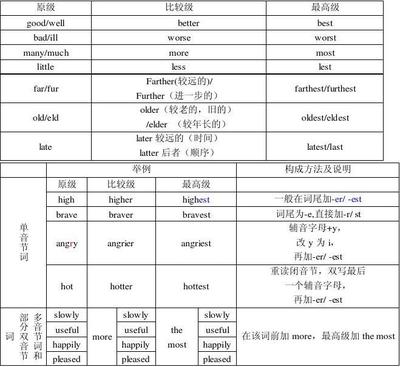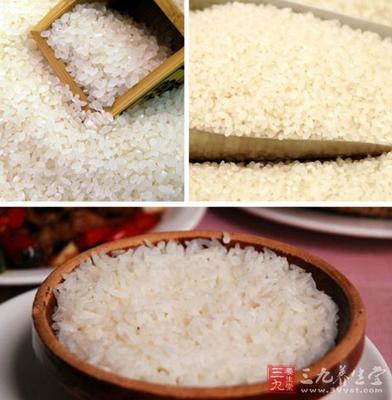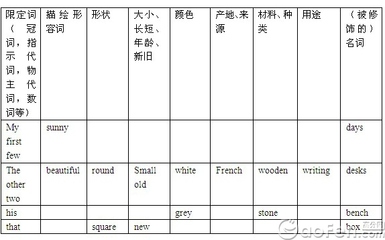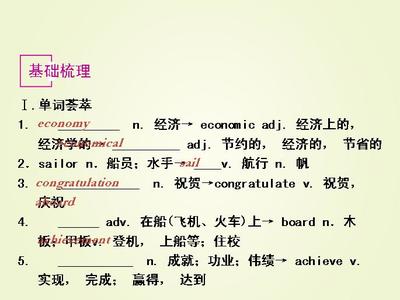形容词
一、形容词的定义、用法
表示人或事物的属性或特征的词叫形容词(Adjective)。形容词修饰名词,它的基本用法就是为名词提供更多的信息,它分为性质形容词和叙述形容词两类,一般放在所修饰的名词之前;若修饰不定代词,则需后置。
形容词的判断方法
判断一个词是不是形容词,可以从其结构特点和句法特点两方面来确定。
(1)结构特点。
以-able,-al,-ful,-ic,-ish,-less,-ous,-y等后缀结尾的词,一般是形容词,如:changeable(多变的),medical(医学上的),careful(仔细的),atomic(原子的),foolish(愚蠢的),careless(粗心的),delicious(美味的),healthy(健康的),rainy(下雨的)等。
(2)句法特点。
大多数形容词都可以作定语;在be,look,seem等词之后作表语;可用very来修饰,有比较级和最高级形式。其中,在句中作定语或作表语是形容词最
主要的特点,如:
Mary is verynice.玛丽很可爱。(表语)
Mary is a nicegirl.玛丽是个可爱的女孩。(定语)
He wasasleep.他睡着了。(表语)
She is a perfectteacher.她是位十全十美的老师。(定语)
形容词的用法
1.形容词用作定语
Li Mei is a beautiful citygirl.李梅是一个漂亮的城市女孩。
The new student comes fromJapan.那个新来的学生是日本人。
2.形容词用作表语
My father’scar is veryexpensive.我父亲的小车很贵。
The English story is veryinteresting.那个英文故事很有趣。
3.形容词用作宾语补足语
Don’tkeep the door open.别让门敞着。
His success made himhappy.他的成功让他感到幸福。
We finally found thedictionaries very useful.我们最后发现词典很有用。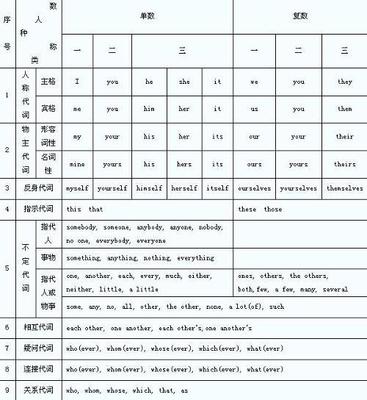
4.“the+形容词”用作主语及宾语
The old often think of oldthings.老年人经常回想往事。
The new always take the placeof the old.新生事物总是会取代旧的事物。
5.形容词有时也可用作状语或补语
Please speak loud andclear.请说话大声一点、更清楚点。
These soldiers spent threedays in the cold weather,cold and hungry.
士兵们又冷又饿在严寒的气候中过了三天。
After seven days, thechildren came back from the forest safe.
七天之后,孩子们安全地从森林中返回。
6.少数形容词只能作表语
这些形容词包括ill,asleep,awake,alone,well,worth,glad,unable,afraid等,只能作表语,不能作定语。例如:
(正)Don’tbe afraid.(误)Mr Li isan afraid man.
(正)The old man was illyesterday.(误)This is an ill person.
(正)This place is worthvisiting.(误)That is a worth book.
7.少数形容词只能作定语
这些形容词包括little,live(活着的),elder,eldest 等,只能作定语,不能作表语。例如:
(正)My elder brother is adoctor.(误)My brother is elder than I.
(正)This is a littlehouse.(误)The house is little.
(正)Do you want live fish ordead one?(误)The old monkey is still live.
二、形容词的位置
1.形容词一般放在名词前作定语
单个形容词修饰名词时,一般要放在名词的前面。它们的前面常常带有冠词、形容词性物主代词、指示代词、数词等。例如:
a red flower一朵红花aninteresting story一个有趣的故事
six blind men 六个盲人my ownhouse我自己的房子
1).当形容词所修饰的词是由some,any,every,no等构成的不定代词时,形容词必须置于名词之后。例如:
She has something new to tellme.她有一些新的情况告诉我。
I have nothing important todo today.今天我没有重要的工作要做。
Do you know anybody elsehere?这儿你还有认识的人吗?
2).形容词后面有介词短语或不定式短语时,形容词必须置于名词之后。例如:
It is a problem difficult towork out.这是一道难以解决的问题。
Edison is a student difficultto teach.爱迪生是个很难教的学生。
This is a kind of flowerseasy to grow.这是一种易栽的花。
3).在以下特殊用法中,形容词置于所修饰的名词之后。例如:
All people,young orold,should be strict with themselves.
所有的人,无论老少,都应该严格要求自己。
We are building a new school,modern and super.
我们正在建一所现代化的高档次的新型学校。
All countries, rich and poor,should help one another. 所有的国家,无论穷富都应该互相帮助。
4).有少数形容词,如enough和possible,既可置于所修饰的名词前面也可以置于它所修饰的名词之后。例如:
Do you have enough time(timeenough)to prepare?你有足够的时间做准备吗?
Maybe it will be a possiblechance(chance possible)for you.或许它将成为一次可能的机遇。
5).有些形容词,置于名词之前与之后,含义不尽相同。例如:
the writer present出席的作者
the present writer现在的作者
2.两个以上的形容词修饰一个名词时的排列顺序
限定词→一般描绘性形容词→表示大小、长短、高低的形容词→表示形状的形容词→表示年龄、新旧的形容词→表示色彩的形容词→表示国籍、地区、出处的形容词→表示物质、材料的形容词→表示用途、类别的形容词→名词中心词。例如:
an exciting internationalfootball match
一场令人激动的国际足球赛
a new red sportsshirt
一件新的红色运动衫
a light black plasticumbrella
一把轻的黑塑料伞
asmall old brown wooden house
一座小的旧的棕色的木头房子
巧记形容词的排列顺序
不少学生对如何排列形容词的词序颇感困惑。在此,我们向同学们介绍一个简易的记忆方法。即请你记住“限观形令色国材”这几个字,这似乎有点不大好记,那就请你记住“县官行令谢国材”吧。它们可以帮你掌握英语里形容词的排列次序。其分别的含义是:
“县”(限)代表限定词,包括:冠词、指示代词、形容词性物主代词、名词所有格、数词等。
“官”(观)代表表示观点的描绘性形容词,如:fine,beautiful,interesting等。
“行”(形)代表表示大小、长短、高低及形状的形容词,如:small,tall,high,little,round等。
“令”(龄)代表表示年龄、新、旧的形容词,如old,young等。
“谢”(“色”的近似音)代表表示颜色的形容词,如:white,black,yellow等。
“国”代表表示国籍、地区、出处的形容词(名词),如:English,American,mountain等。
“材”则代表形成中心名词的材料的形容词,如:stone,wooden,silk,plastic等。
多个形容词同时修饰同一个名词时,就按上述顺序排列,然后加上中心名词。例如:
1.a fine old stonebridge一座古老漂亮的石头桥
2. two big round new Chinesewooden tables
两张新的中国式的木制大圆桌
3. his large new blackforeign car
他那辆新的大型黑色外国进口汽车
特别连接.常见的后跟形容词作表语的词:
①become,come,fall,get,go,grow,make,turn,wear(表示“变成某种状态”)
②continue,hold,keep,lie,remain,stay(表示“保持某种状态”)
③appear,feel,look,smell,sound,taste,know,write(表示“感觉”)
例如:
He turned red when he heardthe news.听到这个消息,他的脸变红了。
It’sgoing to stay cold for sometime.天气还要冷一阵子。
The beer tastes verydelicious.这啤酒尝起来很可口。
三、形容词的比较等级
1.形容词原级的用法
形容词的原级常用于“as…as”及“not as(so)…as”两种句型中。
1).句型“as…as”,表示两者相比较,程度相同。例如:
The old man walks as fast asa young man.这位老人走路与青年人一样快。
Science is as important asmaths.自然科学与数学一样重要。
This coat is as expensive asthat one.这件上衣与那件一样贵。
2).句型“not as(so)…as”,表示两者相比较,程度不一样。例如:
I’mnot as tall as Jack.我不如杰克高。
Shedoesn’trun so fast as I.她不如我跑得块。
This warship is not so big asthat one.这条军舰不如那条大。
同级比较歌诀
同级比较用原级,as…as不分离;若是否定加not,as…as否前者。
as…as加not,只说两者有区别。so…as加not,后者总是强前者。
3).在使用“as…as”与“not as(so)…as” 句型,应该特别注意“as…as”或“not as(so)…as”中间的形容词必须是形容词的原级。例如:
(正)Today is as warm asyesterday.(误)Today is as warmer as yesterday.
(正)I’mnot so careful as mybrother.(误)I’mnot so morecareful as my brother.
4).需要注意的原级形容词用法:
①“数词+times+as+形容词原级+as”(是……的几倍)。例如:
This tree is twice as shortas that one.这棵树比那棵树矮两倍。
My scores are three times asmany as yours.我的比分是你的三倍。
This road is four times aswide as that one.这条马路的宽度是那条的四倍。
②“half+as+形容词原级+as”(……的一半……)。例如:
My English is not half asgood as yours.我的英语不如你的一半好。
This town is half as big asours.这个城镇有我们的城镇一半大。
The rivers in the northaren’thalf as many as those inthe south. 北方的河流不如南方的一半多。
③“as…as”结构中,若形容词作定语修饰可数名词单数,不定冠词a(an)应置于形容词与名词之间。例如:
English is as important asubject as maths.英语和数学是同样重要的一门学科。
Uncle Wang is as good a manas my father.王叔叔是与我父亲同样好的一个人。
This is as famous a school asours.这是一所与我们学校同样著名的学校。
④“as…as”结构若指同一个人或物,则并无比较意义,而只是说明某人或某物具有两种性质。译为“又……又……”或“不但……而且……”。例如:
This computer is as good asit is cheap.这台电脑质量又好又便宜。
The boy is as strong as he isbrave.这个男孩又健壮又勇敢。
The city of Suzhou is asbeautiful as it is clean.苏州城既美丽又干净。
2.形容词的比较等级的构成略
3.形容词的比较级的用法
1)表示两者之间比较时,用“形容词比较级+than”或“less……than”两种句型。例如:
Your mother looks healthierthan before.你妈妈看上去比以前健康了。
I’mless interested inbasketball than you.我对篮球的兴趣不如你大。
2).形容词的比较级还可以用于以下句型中。
①more andmore……(越来越……)。例如:
The park is getting more andmore beautiful.这个公园变得越来越美了。
China had become stronger andstronger.中国已变得越来越强大了。
②themore……the……(越……就越……)。例如:
The more books we read, thecleverer we will become. 我们读的书越多,就会变得越聪明。
The more trees, the better.树越多越好。
The sooner, the better.越早越好。
The more exercise we take,the healthier we are.我们越锻炼,身体就越健康。
③“the+比较级+of thetwo……(两个中较……的一个)”。例如:
I’dlike to go to the farther ofthe two places.两个地方相比较,我愿意去更远的一个。
She is the fatter of the twogirls.她是那两个女孩中较胖的一个。
④“比较级+than anyother+单数名词(比其他任何……都……)”。例如:
Li lei is taller than anyother boy in his class.
李雷比他班上任何一个男孩都高。(暗指:李雷最高)
The population of China islarger than any other’s in theworld.
中国的人口比世界上任何国家的人口都多。(暗指:中国人口最多)
3).形容词的比较级前还可以用much,a lot,far, even, still, a little, no,any等表示程度的词来修饰。例如:
I feel a little better thanyesterday.我感觉比昨天好一点儿了。
The job is far more difficultthan before.这工作比以前要难得多。
4.形容词的最高级的用法
1)三者或三者以上相比较用“the+最高级+名词+范围”。例如:
This is the cleanest place ofthe city.这是这个城市最清洁的地方。
Hu Yun is the fastest of allthe girls in our class.胡云是我们女生中跑得最快的。
2).表示“最……之一”,用“one ofthe+形容词最高级+复数名词”。例如:
The Great Wall of China isone of the greatest buildings in theworld.中国的长城是世界上最伟大的建筑之一。
This is one of the mostinteresting books that Ive everread.这是我读过的最有趣的书之一。
注意.形容词的最高级前面必须加定冠词the,但当形容词最高级前面有物主代词修饰时,则不加the。例如:
(正)This is my bestfriend.
(误)This is my the(the my)best friend.
(正)Today is the happiest dayof my life.
(误)Today is happiest day ofmy life.
 爱华网
爱华网